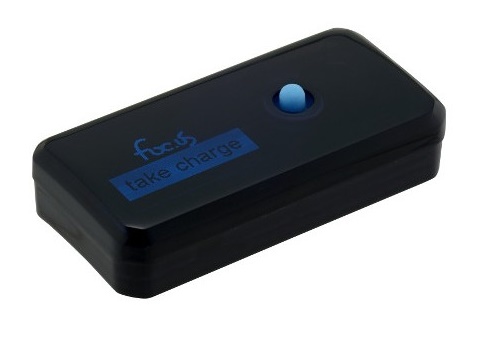Difference between revisions of "Foc.us"
(Main Characteristics) |
(Main Characteristics) |
||
| Line 33: | Line 33: | ||
}} | }} | ||
| − | Foc.us is small [[Transcranial direct-current stimulation|tDCS]] (transcranial direct-current stimulation) device. It was developed by small London based company. The first version of the device was focused on video game players, but the current version could be used for brain stimulation in general. In addition, the current version of Foc.us, Foc.us V2, could deliver also different types of brain stimulation, namely [[Cranial electrotherapy stimulation|cranial electrotherapy stimulation]], transcranial pulsed current stimulation, transcranial random noise stimulation and double blind sham stimulation.<ref>FOC.US. The foc.us v2 stimulator. Foc.us [online]. Available online at: http://eu.foc.us/v2 (Retrieved 25th November, 2016).</ref> | + | Foc.us is small [[Transcranial direct-current stimulation|tDCS]] (transcranial direct-current stimulation) device. It was developed by small London based company. The first version of the device was focused on video game players,<ref name="Game Rant review"/> but the current version could be used for brain stimulation in general. In addition, the current version of Foc.us, Foc.us V2, could deliver also different types of brain stimulation, namely [[Cranial electrotherapy stimulation|cranial electrotherapy stimulation]], transcranial pulsed current stimulation, transcranial random noise stimulation and double blind sham stimulation.<ref>FOC.US. The foc.us v2 stimulator. Foc.us [online]. Available online at: http://eu.foc.us/v2 (Retrieved 25th November, 2016).</ref> |
| − | The first version of the device consists of a headset, which includes four sponge electrodes. | + | The first version of the device consists of a headset, which includes four sponge electrodes and the device was controlled by buttons and app. It was also shipped with small water bottle and charging cable.<ref name="Game Rant review"/> |
| Line 65: | Line 65: | ||
== Public Policy == | == Public Policy == | ||
<!-- Information related to any regulations (law, patents, ISOs, government recommendations and so on.) --> | <!-- Information related to any regulations (law, patents, ISOs, government recommendations and so on.) --> | ||
| − | Foc.us was not approved by FDA since it is not a medical device. <ref> DYCE, Andrew. Foc.us Headset Review. Game Rant [online]. Available online at: https://gamerant.com/focus-tdcs-headset-reviews/ (Retrieved 24th November, 2016).</ref> | + | Foc.us was not approved by FDA since it is not a medical device. <ref name="Game Rant review"> DYCE, Andrew. Foc.us Headset Review. Game Rant [online]. Available online at: https://gamerant.com/focus-tdcs-headset-reviews/ (Retrieved 24th November, 2016).</ref> |
It received FCC approval in June 2013.<ref name="The first commercial tDCS"/> | It received FCC approval in June 2013.<ref name="The first commercial tDCS"/> | ||
Revision as of 10:06, 25 November 2016
| Foc.us | |
|---|---|

|
|
| Category | Transcranial direct-current stimulation, Cranial electrotherapy stimulation |
| Developer | Transcranial Ltd. |
| Announced | |
| Released | Developers: 13th November 2014 (V2 edition)[1]
Consumers: June 2013 [2] |
| Price | 199 USD (November 2016) |
| Max output | 2 mA2 T 0.002 A [3] |
| Session duration | 24002,400 s 40 minute |
| Scalp location | |
| Weight | g |
| Controls |
joystick, smartphone, tablet, personal computer [4] |
| Data available | |
| Risk factor | |
| Medical prescription | No |
| http://eu.foc.us/v2 | |
Foc.us is small tDCS (transcranial direct-current stimulation) device. It was developed by small London based company. The first version of the device was focused on video game players,[5] but the current version could be used for brain stimulation in general. In addition, the current version of Foc.us, Foc.us V2, could deliver also different types of brain stimulation, namely cranial electrotherapy stimulation, transcranial pulsed current stimulation, transcranial random noise stimulation and double blind sham stimulation.[6]
The first version of the device consists of a headset, which includes four sponge electrodes and the device was controlled by buttons and app. It was also shipped with small water bottle and charging cable.[5]
Contents
Main characteristics
Purpose
Company & People
Important Dates
Enhancement/Therapy/Treatment
Ethical & Health Issues
Public & Media Impact and Presentation
Public Policy
Foc.us was not approved by FDA since it is not a medical device. [5]
It received FCC approval in June 2013.[2]
Related Technologies, Projects or Scientific Research
References
- ↑ FOC.US. After a long anticipated wait the new Foc.us V2 Developer edition is now available for pre order!!. Facebook [online]. 2014, Nov 13. Available online at: https://www.facebook.com/focusgamer (Retrieved 24th November, 2016).
- ↑ 2.0 2.1 ANTHONY, Sebastian. Foc.us: The first commercial tDCS headset that lets you safely overclock your brain. ExtremeTech [online]. 2013, Jul 30. Available online at: https://www.extremetech.com/extreme/162581-foc-us-the-first-commercial-tdcs-headset-that-lets-you-safely-overclock-your-brain (Retrieved 24th November, 2016).
- ↑ FOC.US. Curent Regulation in foc.us v2. Foc.us [online]. 2015, Feb 16. Available online at: http://help.foc.us/article/11-curent-regulation-in-foc-us-v2 (Retrieved 24th November, 2016).
- ↑ FOC.US. Do I need an app to control foc.us v2?. Foc.us [online]. 2014, Nov 13. Available online at: http://help.foc.us/article/6-do-i-need-an-app-to-control-foc-us-v2 (Retrieved 24th November, 2016).
- ↑ 5.0 5.1 5.2 DYCE, Andrew. Foc.us Headset Review. Game Rant [online]. Available online at: https://gamerant.com/focus-tdcs-headset-reviews/ (Retrieved 24th November, 2016).
- ↑ FOC.US. The foc.us v2 stimulator. Foc.us [online]. Available online at: http://eu.foc.us/v2 (Retrieved 25th November, 2016).
- ↑ WEXLER, Anna. A pragmatic analysis of the regulation of consumer transcranial direct current stimulation (TDCS) devices in the United States. Journal of Law and the Biosciences [online]. 2015, Oct 12. Available online at: http://jlb.oxfordjournals.org/content/2/3/669.full.pdf+html (Retrieved 1st November, 2016).